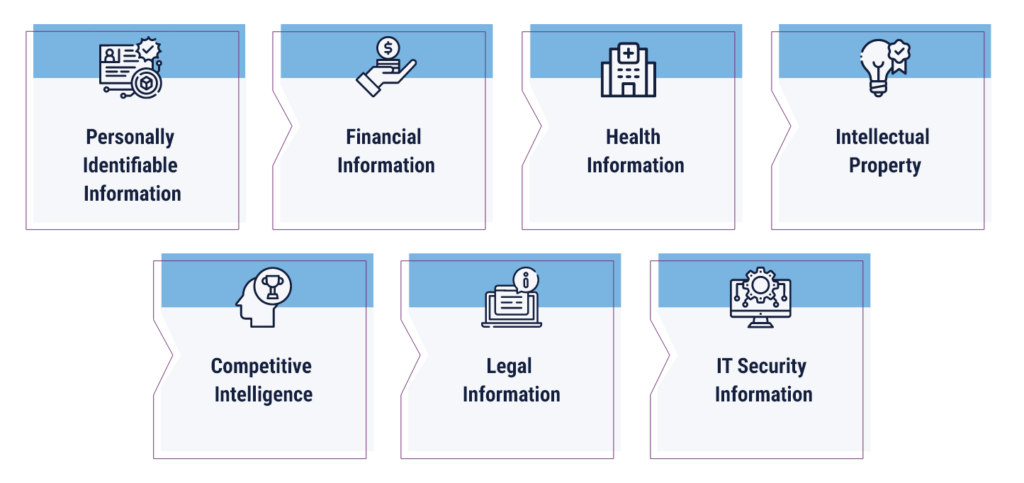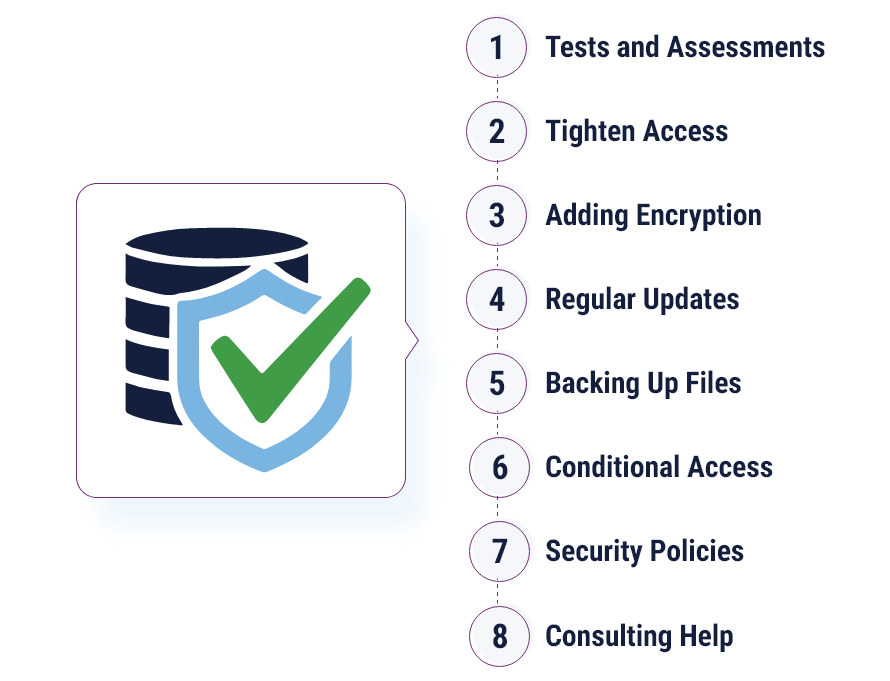June 8, 2023 | Matt Pacheco
Exploring the Consequences of Data Breach: Risks & Implications

Data breaches are a growing problem, and costly in more ways than one. In 2022, the average cost of a data breach hit an all-time high according to IBM, reaching $4.35 million. What’s worse, 83% of organizations have experienced more than one breach, which can lead to an erosion of trust and irreplaceable revenue losses. We’ll discuss how data breaches occur, what data is targeted most often, the consequences that can come after a data breach, and how organizations can protect themselves from incoming threats.
What is a Data Breach?
A data breach is any event where data is stolen, accessed, changed, copied, or sent elsewhere, without the consent or knowledge of the organization that owns the data. Outside threat actors, such as cybercriminals, can instigate a data breach. It can also be something that happens from the inside, either due to lax security controls, internal bad actors, or improper disposal of equipment.
For companies, a data breach can start as a small crack in the foundation and quickly turn into a large, structural issue.
How do Data Breaches Occur?
The most common cause of a data breach, according to IBM’s Cost of a Data Breach 2022 report, comes from compromised or stolen credentials. Approximately one in five breaches occur due to this attack vector. Other common causes of data breaches include phishing, cloud misconfiguration, vulnerabilities present in third-party software, and malicious insiders.
Organizations may also experience data breaches due to a compromise in physical security, a system error, a compromise to business email, social engineering, or data or a device that gets lost on accident.
Types of Data Breach Targets
All businesses are prone to data breaches, regardless of size or industry. However, there are some types of data that are more attractive to hackers, increasing the likelihood of a breach.

Personally Identifiable Information
Personally identifiable information (PII) is any kind of data that can be linked back to an identifiable person. This personal data can include driver’s licenses, dates of birth, social security number, email addresses, phone numbers, credit card numbers, or passwords that are tied to a person’s name, username, or other factors that identify them.
Financial Information
Financial information, especially when associated with personal information, is especially vulnerable to data breaches. Any financial information gained in a data breach can be used to commit fraud or identity theft, where a bad actor can make unauthorized purchases or reports in someone else’s name.
Health Information
It may sound strange that health information is often stolen and compromised. However, healthcare remains the most expensive industry in terms of data breaches for 12 years running. The cost of a data breach in this industry averaged $10.10 million in 2022, with the financial industry at a distant second incurring $5.97 million in costs on average. Similarly to financial information, health information can include extremely sensitive PII such as social security numbers, which can be used to commit identity theft. In financial breaches, sometimes only one or two pieces of important information can be revealed. With health information, there is often a wider array of PII available in one place.
Intellectual Property
If an organization has valuable intellectual property, this may also be the motivation for a data breach. Trade secrets, in-process patents, or other confidential information may be highly valuable if sold to the right buyer. Malicious insiders may know someone who wants this information – just over 10% of all data breaches are attributed to actions from people on the inside.
Competitive Intelligence
Similarly, competition information may be of interest to the right audience. Whether a business has collected information about their competitors, or a competitor is interested in uncovering more about the pricing or marketing strategies of a business, certain information can be used to gain a competitive advantage.
Legal Information
Legal documents, such as agreements and contracts, may be valuable, especially for the sensitive data they can contain. Data that is found in legal information can be used to commit fraud, similar to financial and health information.
IT Security Information
Just like PII can open the floodgates and uncover more sensitive information as criminals connect the dots, IT security information can play the same role in the systems of an organization. Uncovering passwords or other important credentials can serve as an open door, sometimes allowing access to entire systems.
14 Consequences of Data Breach
Data breaches can cause both short-term and long-ranging consequences, and they can impact everyone from the people in the organization to partners and end users with tangential connections. Here are some of the biggest consequences of a data breach for a company:
- Increased Downtime: If data has been compromised and parts of the system need to be shut down in order to contain it, or worse, the breach includes a ransomware attack, where data is being held hostage, this can contribute to increased downtime for a company. The second-highest share of cost from a data breach comes from revenue loss and business disruption from the event, much of which is attributed to downtime.
- Intellectual Property Theft: Intellectual property that is stolen could result in a competitor coming out with a product in development to gain an edge, a counterfeit product hitting the market, or could cause other damage to a business.
- Remediation Costs: Detection and escalation costs cause the greatest expense when a company experiences a data breach. On average, it costs a company $1.44 million to engage in forensics and investigations, crisis management, assessments and audits, and communications campaigns that are all part of remediation measures. Post-breach responses, including help desking, legal costs, regulatory fines, product discounts, and more cost a business $1.18 million on average.
- Direct Financial Loss: Downtime is a major contributor to direct financial loss – If a business cannot operate normally, revenue that would come in during that time naturally decreases.
- Regulatory Fines and Penalties: Part of the remediation after a breach comes from paying regulatory fines and penalties. If the security measures in place didn’t meet regulatory standards, this can become a costly endeavor for companies.
- Lawsuits and Claims: Operating in a non-compliant way can also open an organization up to lawsuits and claims for damages. Companies may have to offer ongoing credit reporting services or pay end users for data that was compromised.
- Lost Business Opportunities: Financial loss can also stem from losing out on new business opportunities during a data breach.
- Impact on Customer Trust: Current clients who feel exposed or vulnerable from a data breach, even if their data has not been accessed or compromised, can lose trust in a business. This may result in them pulling their support for the company, which can also decrease revenue.
- Damage to Brand: Prospective clients, customers, and audiences at large may view a brand differently after a data breach. If the correct remediation measures are not taken, or a communication campaign falls short, people may associate a specific brand with being unsafe or untrustworthy. This can cause lasting damage to a brand’s image.
- Employee Confidence and Morale: Employee reception post-data breach will depend on the way the company handles the breach, how well they communicate with all affected parties, and the degree to which employee data has been affected. If there are holes in the process, this can impact employee confidence and morale, and may even lead to retention issues.
- Identity Theft and Fraud: Because most of the information attractive to cybercriminals is directly related to the ability to perform identity theft and fraud, it’s natural that this is a major consequence of a data breach. Some identity theft may surface soon after a breach has occurred. Others may take days or months to materialize. It can take up to a year to identify and contain a data breach caused by stolen or compromised credentials, meaning a lot of damage can be done in that time.
- Extortion: Ransomware can also be involved in a data breach. With ransomware, cybercriminals encrypt the data and then demand a ransom to un-encrypt the data. The companies that end up paying the ransom often are unable to maintain data resiliency and don’t get all of their data back after the fact. Extortion can also be carried out by insiders looking for money or ownership over intellectual property.
- Legal Obligations and Cost: One legal cost from a data breach is connected to lawsuits and damages. Another comes from legal fees an organization may have to pay for counsel. Implementing new security measures, notifying affected parties, and investigating the breach may all be legal steps a business has to take to remain compliant and limit their liability after a breach.
- Changes to Laws and Regulations: If a data breach is large enough, it might spur larger action from regulatory bodies. Businesses may be required to comply with new rules around notification, cyber insurance, data privacy best practices, and more.
How to Reduce Data Breach Risk and Eliminate Consequences
There will always be individuals and organizations dedicated to finding vulnerabilities in systems, looking to capitalize on weak areas. However, there are many different steps businesses can take to reduce their risk of a data breach and eliminate some of the more harmful consequences that come from being a victim of a breach.

Tests and Assessments
Several types of tests and assessments can be used to lower the risk of a data breach:
- Security audits can be used to confirm a business is abiding by security policies and regulatory guidelines.
- Vulnerability assessments can help find security vulnerabilities in the systems and networks of a business before they are found by hackers.
- Penetration testing involves an ethical hacker who tries to exploit a system to find gaps in security controls.
- Finally, employee training instills a culture of cybersecurity in an organization. Businesses can use training to solidify best practices. They can also use regular tests to identify which employees may benefit from additional training.
Tighten Access
Chances are good that most employees don’t need access to everything in your system. Tighten access so that only the necessary parties have access to the most sensitive information, such as health or financial data and other PII. You can also implement access by keycard, multifactor authentication, computer timeouts after a certain number of minutes without use, and more.
Adding Encryption
Encrypting data means that it is inaccessible without a special key. Data should be encrypted at rest (when stored on a physical device) or in transit (when it is being transmitted over a network). It can also be encrypted when in use (while data is being processed by a system). Increasing encryption will reduce the likelihood of a data breach.
Regular Updates
It’s not uncommon for vulnerabilities to come from problems that have just been discovered in a third-party tool. If your organization doesn’t have a plan to patch and update regularly, these can create unnecessary openings for data breaches. “Patch Tuesday,” the second Tuesday of the month, is a common time for software companies to release patches. Ensure you have a consistent schedule to check for and run updates, as well as a system for identifying patches that are especially critical.
Backing Up Files
One of the biggest costs of a data breach is the time and resources it takes to get the business moving again. Having a solid backup and data recovery system can reduce this cost and the time it takes to restore data. With the highest levels of backup and recovery, restoring systems can take mere minutes, with minimal data loss.
Conditional Access
Similar to tightening access, conditional access may mean limiting access for users based on specific conditions, such as the time of day, the device they are using, or their location.
Security Policies
Any security policies that get added will continue to strengthen an organization’s security posture. They can include the tests and assessments, access control, and encryption mentioned above. They can also include new password policies, intrusion detection systems, firewalls, and more.
Consulting Help
If you feel you lack the internal expertise to significantly reduce your risks associated with data breaches, it’s a good idea to seek outside help. Managed security providers and other cybersecurity specialists can consult and even help your organization implement best practices that will limit your risk of a data breach.
Using IT Security Services to Prevent a Data Breach
Threats can come from many sides. It’s easier to prevent a data breach by having a partner in your corner. TierPoint’s IT security services can help you build a multilayered approach (using solutions like CleanIP XDR) to guard against today’s most prominent cyber threats and address compliance concerns, improve your security posture, and cater solutions to the way your organization works.
Interested in learning more about the top threats to cloud security and key defenses? Download our whitepaper today.

FAQs
After a data breach, a business can experience much more than data loss, including financial losses, damage to reputation and trust, and consequences stemming from compliance issues or legal liabilities.
If a data breach occurs, the faster it is identified and contained, the better. Affected parties should be notified for protection and transparency purposes. Meanwhile, organizations need to investigate the breach, enact new security measures to mitigate the risk of future breaches, and communicate about the steps they’re taking as they are happening to retain trust.
While data breaches are ultimately attributable to the hacker or bad actor that caused the breach in the first place, it can be hard to track them down and prosecute. The responsibility often falls on either the owner of the data or the third-party vendor that was in charge of protecting the data.
